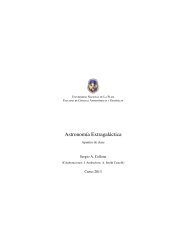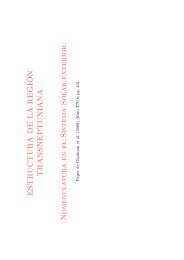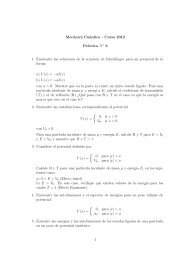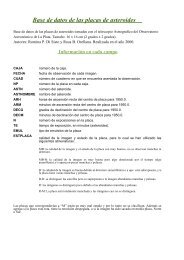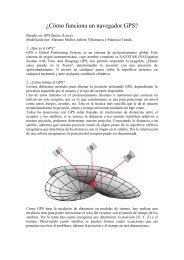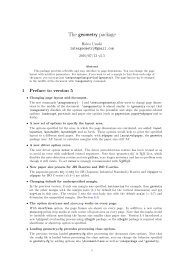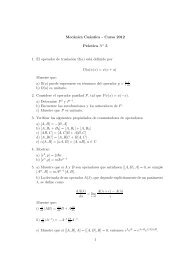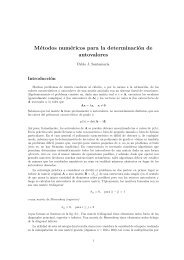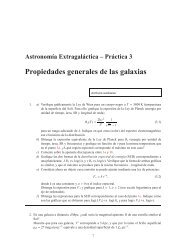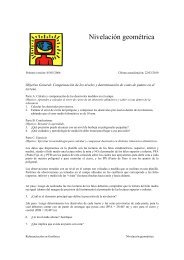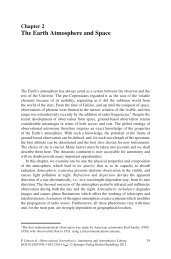Surface brightness profiles of dwarf galaxies in the NGC 5044 Group
Surface brightness profiles of dwarf galaxies in the NGC 5044 Group
Surface brightness profiles of dwarf galaxies in the NGC 5044 Group
Create successful ePaper yourself
Turn your PDF publications into a flip-book with our unique Google optimized e-Paper software.
S.A. Cellone: Dwarf <strong>galaxies</strong> <strong>in</strong> <strong>the</strong> <strong>NGC</strong> <strong>5044</strong> <strong>Group</strong> 409orS e = S 0 + 5 log(reα) [ Γ(2− 2.5 logN )N]. (5)It can be shown that reα depends only on N, and <strong>the</strong>n S e doesnot depend on α. These calculated parameters are also shown <strong>in</strong>Table 4. The magnitudes and colours <strong>in</strong> Table 3, <strong>in</strong>stead, wereobta<strong>in</strong>ed from <strong>the</strong> observed <strong>pr<strong>of</strong>iles</strong> with no model assumption,to allow for those <strong>galaxies</strong> whose <strong>pr<strong>of</strong>iles</strong> couldn’t be fitted with<strong>the</strong> model.4. See<strong>in</strong>g effectsThe effects <strong>of</strong> see<strong>in</strong>g on <strong>the</strong> photometric parameters<strong>of</strong> elliptical <strong>galaxies</strong> have been studied us<strong>in</strong>g differenttechniques (e. g.: Franx et al. 1989; Peletier et al. 1990;Saglia et al. 1993b). These studies have shown that <strong>the</strong> effects <strong>of</strong>see<strong>in</strong>g on surface <strong>brightness</strong> and ellipticity <strong>pr<strong>of</strong>iles</strong> may extendup to several PSF radii.The observations presented <strong>in</strong> this paper were obta<strong>in</strong>ed underra<strong>the</strong>r mediocre see<strong>in</strong>g conditions and, <strong>in</strong> addition, <strong>the</strong> telescopehad small track<strong>in</strong>g errors. This resulted <strong>in</strong> a non-circularPSF, with Gaussian fits to its m<strong>in</strong>or and major axis giv<strong>in</strong>gFWHM Y ≃ 2.0 ′′ and FWHM X ≃ 2.8 ′′ , respectively, withsmall variations between different frames. However, <strong>the</strong> actualshape <strong>of</strong> <strong>the</strong> PSF was not Gaussian, hav<strong>in</strong>g notably larger w<strong>in</strong>gs.The adopted approach, <strong>the</strong>n, was to evaluate <strong>the</strong> effects <strong>of</strong> see<strong>in</strong>gon this particular set <strong>of</strong> observations us<strong>in</strong>g an empirical PSFobta<strong>in</strong>ed from <strong>the</strong> same data us<strong>in</strong>g IRAF–DAOPHOT rout<strong>in</strong>es.A set <strong>of</strong> artificial <strong>galaxies</strong> follow<strong>in</strong>g a perfect Sérsic law andspann<strong>in</strong>g a broad range <strong>in</strong> <strong>the</strong> relevant parameters was generated,and <strong>the</strong>n convolved with <strong>the</strong> empirical PSF. The surface<strong>brightness</strong> <strong>pr<strong>of</strong>iles</strong> <strong>of</strong> <strong>the</strong>se convolved artificial <strong>galaxies</strong> were<strong>the</strong>n obta<strong>in</strong>ed and fitted with a Sérsic law, <strong>in</strong> <strong>the</strong> same way aswas previously done with <strong>the</strong> observed <strong>galaxies</strong>. The effects<strong>of</strong> see<strong>in</strong>g were evaluated by compar<strong>in</strong>g <strong>the</strong> “observed” and <strong>the</strong>“orig<strong>in</strong>al” parameters for <strong>the</strong> convolved artificial <strong>galaxies</strong>.A total <strong>of</strong> 55 artificial <strong>galaxies</strong> were generated with fixedcentral surface <strong>brightness</strong>, and spann<strong>in</strong>g <strong>the</strong> follow<strong>in</strong>g ranges<strong>in</strong> scale length and shape parameter: 0.001 ′′ ≤ α ≤ 10 ′′ , and0.25 ≤ N ≤ 1.50, respectively. Most <strong>of</strong> <strong>the</strong>m were round, butseveral non-circular (ɛ =0.5) and a few “nucleated” artificial<strong>galaxies</strong> (i. e., with a po<strong>in</strong>t source 10% <strong>the</strong> lum<strong>in</strong>osity <strong>of</strong> <strong>the</strong>galaxy added at its centre, before <strong>the</strong> convolution) were alsogenerated, <strong>in</strong> order to check for any differences compared tocircular, non-nucleated <strong>galaxies</strong>. No noise or constant sky levelwere added. Although a complete study <strong>of</strong> see<strong>in</strong>g and <strong>in</strong>strumentaleffects would require <strong>the</strong> <strong>in</strong>clusion <strong>of</strong> <strong>the</strong>se factors, alongwith <strong>the</strong> generation <strong>of</strong> a larger sample <strong>of</strong> artificial <strong>galaxies</strong> convolvedwith different PSFs, <strong>the</strong> present approach is sufficient toevaluate <strong>the</strong> global effects <strong>of</strong> see<strong>in</strong>g on <strong>the</strong> measured photometricparameters <strong>of</strong> this particular sample <strong>of</strong> <strong>galaxies</strong>.Fig. 2 shows <strong>the</strong> differences between each measured parameterand <strong>the</strong> orig<strong>in</strong>al one [∆S 0 , ∆ log(α), and ∆ log(N), respectively]aga<strong>in</strong>st <strong>the</strong> measured effective radius r e . It is evident thatfor sufficiently large <strong>galaxies</strong> <strong>the</strong> orig<strong>in</strong>al parameters are recovabcFig. 2a–c. Measured (after convolution with PSF) m<strong>in</strong>us orig<strong>in</strong>al parametersaga<strong>in</strong>st measured effective radius for 55 artificial <strong>galaxies</strong>:a central surface <strong>brightness</strong>, b logarithm <strong>of</strong> scale length, and c logarithm<strong>of</strong> shape parameter. Squares: round, non-nucleated <strong>galaxies</strong>;triangles: ɛ =0.5, non-nucleated <strong>galaxies</strong>; crosses: round, nucleated<strong>galaxies</strong>. Dashed l<strong>in</strong>es are least-squares fits for log(r e) ≤ 0.5 ′′ .ered with small errors, but for <strong>galaxies</strong> with r e 5 ′′ <strong>the</strong> parametersare systematically underestimated because <strong>of</strong> see<strong>in</strong>g andsampl<strong>in</strong>g effects. (Note that, at least <strong>in</strong> pr<strong>in</strong>ciple, it seems possibleto recover <strong>the</strong> orig<strong>in</strong>al parameters for <strong>the</strong> smaller <strong>galaxies</strong>;however, <strong>the</strong> scatter is large, specially for N, and try<strong>in</strong>g to apply



